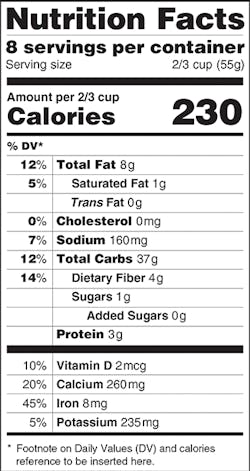Consumers Respond To Proposed FDA Nutrition Label
The Food and Drug Administration (FDA) unveiled proposed changes to the 20-year-old nutrition label on food packaging. Changes include increased focus on calories, added sugar critical vitamins and minerals, recalibration of the daily-recommended value of sodium and how serving sizes are determined. Data show missed opportunities, as top three most beneficial changes are not addressed in new design proposal.
A new poll — conducted before the FDA's design was revealed — released from Heart+Mind Strategies, shows the single most beneficial change to the nutrition label to be a radical design change as opposed to what information is shared. Nearly one third of Americans (32 percent) reported creating a star or check system for each food (where more stars means a healthier food) would be the most beneficial to them personally.
Additionally, some of the least beneficial changes are ones on which the new nutrition label is focused, such as the increased emphasis on calories and revised serving size calculations. Full ranking of changes tested follows:
- Creating a star or check system for each food (32 percent)
- Separating out good fats from bad fats (19 percent)
- Ditching the metric system (14 percent)
- Separating out natural sugar from added sugar (14 percent)
- Calculations based on larger serving sizes (12 percent)
- Enhanced focus on calories (7 percent)
- Listing added wheat (3 percent)
Notably all changes tested in the poll were public recommendations by a variety of experts, organizations and individuals.
Incorporating a star or check rating system was recommended by the Institute of Medicine (IOM), which was commissioned by Congress to study nutrition labeling issues over the past couple of years. It is strikingly similar to other successful labeling efforts from the government such as Energy Star, the 5-Star Safety Ratings for vehicle crashes and the Monroney Sticker for vehicle fuel efficiency ratings.
"People are always looking for a quick, reliable way to digest a lot of complex information," said Heart+Mind Strategies CEO Dee Allsop, Ph.D. and research consultant on two government labeling projects, in a prepared statement. He continued, "In point-of-sale environments from the car dealership to the grocery isle, a picture really is worth a thousand words and enhances consumer confidence in the decision-making process."
According to the Journal of the American Dietetic Association, more than 60 percent of Americans use the nutrition fact label when deciding to purchase food. Yet Heart+Mind Strategies found just over one-quarter (28 percent) report the nutrition label as being the most important decision-making influencer when buying food—taste is the leader (39 percent) and price just barely trails nutrition (26 percent).
When it comes to food and diet in general, Americans are predominantly focused on what they put in their bodies (70 percent) as opposed to what they keep out (30 percent), according to the release. And more than half the country (53 percent) considers themselves the best judge on whether or not a food is right or wrong for them. Importantly, the nutrition label has the second most influence on that diagnosis (41 percent), while a doctor's recommendations bear relatively little weight on that decision at all (6 percent).
March is National Nutrition Month—a campaign designed to focus attention on the importance of making informed food choices. As human decision-making experts, Heart+Mind Strategies has identified the five principles of consumer choice. Perhaps the most important for a new nutrition label is to understand the choices we make are affected by the context in which they are made. People are making food choices in a broad range of settings every day, from a grocery store or vending machine to restaurants or their own homes. Whether looking for something convenient, filling, or quick, there is always competition. The new nutrition label must not only be easy to understand, but easy to see (from say behind the vending machine glass or top shelf of the store) and quickly comparable to other choices.
Methodology
This report presents the findings of a survey conducted among a sample of 1,005 adults comprising 502 men and 503 women 18 years of age and older.
The online omnibus study is conducted twice a week among a demographically representative U.S. sample of 1,000 adults 18 years of age and older. This survey was live on Feb. 18 to 20, 2014.
Completed interviews are weighted by five variables: age, sex, geographic region, race and education to ensure reliable and accurate representation of the total U.S. population, 18 years of age and older. The raw data are weighted by a custom designed program which automatically develops a weighting factor for each respondent. Each respondent is assigned a single weight derived from the relationship between the actual proportion of the population based on U.S. Census data with its specific combination of age, sex, geographic characteristics, race and education and the proportion in the sample.
Respondents for this survey were selected from among those who have volunteered to participate in online surveys and polls. The data have been weighted to reflect the demographic composition of the 18+ population. Because the sample is based on those who initially self-selected for participation, no estimates of sampling error can be calculated. All sample surveys and polls may be subject to multiple sources of error, including, but not limited to sampling error, coverage error, error associated with nonresponse, error associated with question wording and response options, and post-survey weighting and adjustments.
